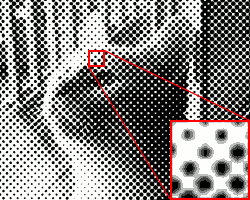Halftone
|
|
Halftoning is a method of printing shades using a single color ink. By varying the size or density of the dots, the eye can see a shade somewhere between the solid colour and the colour of the background paper. The effect has its limits, when the dots get too small or spaced too far apart, the eye starts seeing dots again.
Halftone_example_CMYK.png
A pattern of dots that is used to represent a particular shade is known as a halftone screen. The number of dots measured horizontally in one inch is the typical way of measuring a screen, known as the screen ruling and represented with a hash mark. For instance, a screen with 150 dots per inch would be referred to as "150#".
When different screens meet, a number of distracting visual effects can occur, including the edges being overly emphasized, as well as a moiré pattern. This problem can be reduced by rotating the screens in relation to each other. This screen angle is another common measurement used in printing, measured in degrees clockwise from a line running to the left (9 o'clock is zero degrees).
Halftoning is also commonly used for printing colour pictures. The general idea is the same, by varying the density of the four primary printing colours, cyan, magenta, yellow and black, any particular shade can be reproduced.
In this case there is an additional problem that can occur. In the simple case, one could create a halftone using the same techniques used for printing shades of grey, but in this case the different printing colours have to remain physically close to each other to fool the eye into thinking they are a single colour. To do this the industry has standardized on a set of known angles, which result in the dots forming into small circles or rosettes.
Photographic halftoning utilizes a high frequency/low frequency dichotomy. The low frequency attribute is a local area of the output image called a halftone cell. Each equal-sized cell relates to a corresponding area (size and location) of the continuous-tone input image. Within each cell, the high frequency attribute is a centered variable-sized halftone dot composed of ink or toner.
The ratio of the inked area to the non-inked area of the output cell corresponds to the luminence or graylevel of the input cell. From a suitable distance, the human eye averages both the high frequency apparent gray level approximated by the ratio within the cell and the low frequency apparent changes in gray level between adjacent equally-spaced cells and centered dots.
Digital halftoning has been replacing photographic halftoning since 1986. Digital halftoning utilizes a raster image or bitmap within which each monochrome picture element or pixel may be on or off, ink or no ink. Consequently, to emulate the photographic halftone cell, the digital halftone cell must contain groups of monochrome pixels within the same-sized cell area.
The fixed location and size of these monochrome pixels compromises the high frequency/low frequency dichotomy of the photographic halftone method. Clustered multi-pixel dots cannot "grow" incrementally but in jumps of one whole pixel. In addition, the placement of that pixel is slightly off-center. To minimize this compromise, the digital halftone monochrome pixels must be quite small, numbering up to 2,540 to 3,556 per inch.
External link
- Halftone Screens and Dots (http://www.dtp-aus.com/hlftone.htm)
- Article from the early 1900s on halftoning (http://www.oldandsold.com/articles10/advertising-14.shtml)
- YOUniverse Systems Background Links (http://www.youniverse.com/Background.html)

